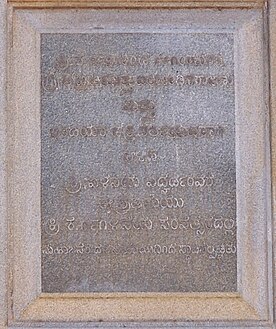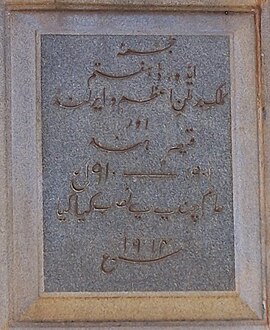Statue of Edward VII, Bangalore
| Statue of Edward VII | |
|---|---|
Statue of King Edward VII in Bangalore | |
| Location | Queen's Park, Bangalore Cantonment, India |
| Coordinates | 12°58′49.07568″N 77°35′41.76024″E / 12.9802988000°N 77.5949334000°E |
| Dedicated | 28 November 1919 |
| Sculptor | Leonard Jennings |





The statue of Edward VII in Bangalore is located at Queen's Park, next to Cubbon Park, Bangalore Cantonment, at the junction of Queen's Road and Cubbon Road. The statue was unveiled in November 1919 by the then Viceroy and Governor-General of India, Frederic John Napier, Baron Chelmsford. The statue was raised out of funds raised by the residents of the Bangalore Civil and Military Station. The Statue of King Edward VII is one of the few of the original statues which were installed in British India, to still stand at its original location. The statue rises above a flowering frangipani tree. On the other end of Queen's Park is the Statue of Queen Victoria, Bangalore.[2][3] The statue was designed and sculpted by Leonard Jennings of Chelsea, London.[4]
Edward VII, Emperor of India
[edit]Edward VII reigned as the King of the United Kingdom and the British Dominions and Emperor of India between 1901 and 1910, following his mother Queen Victoria's death in 1901. In 1875 he had toured British India as subcontinent as the Prince of Wales, but never visited again as Emperor of India. His short reign ended with his death in 1910, and the throne was passed on to his son, George V.
Leonard Jennings
[edit]Leonard Jennings (1877–1956), OBE, designed and sculpted the Statue of King Edward VII at Bangalore. Jennings was born in Acton, London, and studied art at the Lambeth School of Art, Glasgow School of Art and the Royal Academy of Arts. Jennings worked for the Government of India and also taught at the Calcutta School of Art. Most of Jennings's public commissions were in India. These include the statue of King Edward VII at Bangalore, Thackeray Memorial at Calcutta, the Imperial Service Cavalry Brigade Memorial at Teen Murti Bhavan New Delhi, statue of the Prince of Wales (later the Duke of Windsor) commissioned by the Aga Khan at Bombay, marble bust of Nawab Abdul Latif, C.I.E (1913–14) at Calcutta University Senate House, and a 10 ft statue of George V in coronation robes at Patna.[5]
Inscriptions
[edit]Inscription on the statue reads
- EDWARD VII
- KING OF GREAT BRITAIN AND IRELAND
- AND
- EMPEROR OF INDIA
- 1901–1910
- ERECTED BY PUBLIC SUBSCRIPTION
- 1914
-
Edward VII English Inscription (Front)
-
Edward VII Kannada Inscription (Left)
-
Edward VII Tamil Inscription (Right)
-
Edward VII Urdu Inscription (Back)
Further, on the foot of the pedestal, another inscription says
- UNVEILED BY
- HIS EXCELLENCY THE RIGHT HONOURABLE
- FREDERICK JOHN NAPIER BARON CHELMSFORD
- VICEROY AND GOVERNOR GENERAL OF INDIA
- P.C.G.M.S.I., G.C.M.G., G.M.I.E., O.B.E.
- ON THE 28TH DAY OF NOVEMBER 1919
-
Edward VII English Inscription (Front)
There are inscriptions in Kannada on the left, Tamil on the right and Urdu on the back, both on the pedestal and the foot of the pedestal, which are translations of the English Inscriptions.
Present Status
[edit]The Statue of King Edward VII lies largely ignored and neglected as a result of the Bangalore Metro, and lies covered by layers of dirt and dust.[2]
The Horticulture Department, Government of Karnataka have asked for expert reports for restoration of the King Edward VII's Statue, along with the Statue of Queen Victoria and statue of Chamaraja Wodeyar IV. Further it suggested polishing the statue of Edward VII, and pruning of surrounding trees to make the statue more visible.[6][7]
Since the 1960s, a group of political activists led by Vatal Nagaraj, (who is infamous for vandalising the cenotaph pillar which was raised in memory of the lives lost in the Siege of Bangalore, 1791, opposite to the present Corporation Building, and Hudson Memorial Church), has been demanding that the statue of Edward VII, along with that of Queen Victoria and Mark Cubbon be removed. The Government had at one stage accepted these demands and agreed to remove the statues in 1977, but never implemented the decision. Further, historians, and heritage lovers of Banaglore City are enraged with these suggestions of destruction of history and have raised their opposition. Recently members of the Cubbon Park Walkers’ Association garlanded the statue of Mark Cubbon in open defiance of these demands.[8][9]
See also
[edit]References
[edit]- ^ "King Edward VII. Marble Statue for Bangalore, Mysore. Leonard Jennings, Sculptor". Academy Architecture – Sculptures. 45. Alex Koch: 36. May 1914. Retrieved 12 January 2016.
- ^ a b Rodricks, Allan Moses (31 October 2014). "Making their mark in stone". The Hindu. No. Bangalore. Retrieved 12 January 2016.
- ^ Rizvi, Aliyeh (11 April 2013). "A place to see and be seen in". The Hindu. No. Bangalore. Retrieved 12 January 2016.
- ^ Monument Australia. "King Edward VII". Monument Australia. Retrieved 12 January 2016.
- ^ University of Glasgow History of Art (2011). "Leonard Jennings OBE". Mapping the Practice and Profession of Sculpture in Britain and Ireland. Retrieved 12 January 2016.
- ^ Sharadhaa, A (24 April 2014). "Book to Help Park Statue Restoration". No. Bangalore. The New Indian Express. Archived from the original on 19 January 2016. Retrieved 12 January 2016.
- ^ "5 statues in Cubbon Park set for facelift". The Times of India. No. Bangalore. TNN. 19 April 2014. Retrieved 12 January 2016.
- ^ Prasad S, Shyam (15 April 2014). "Kannada activists want Victoria statue moved out". No. Bangalore. Bangalore Mirror. Bangalore Mirror Bureau. Retrieved 11 January 2016.
- ^ "Cubbon garlanded in hush-hush ceremony in front of High Court". No. Bangalore. Bangalore Mirror. 24 August 2013. Retrieved 5 February 2015.






